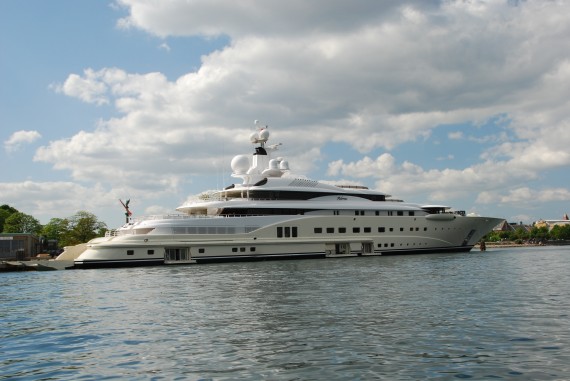I’ve written a lot about the economics of household income over at Investing for Beginners at About.com, a division of The New York Times.
[mainbodyad]Most economic data, as I explained there, comes in the form of regular households that are easily understandable to the average worker. For example, to be in the top 5% of household income, which means you earn more than 19 out of 20 households, you need to earn at least $157,176 per year. Most of these top-ranking households have dual income earners where both spouses work. That is, it would take two college graduates earning $78,588 to rank among that top quintile if they were married and living under the same roof.
The Five Levels of “The Rich” in the United States
But what about “the rich”. Where do the dividing lines for the rich fall? I’ve been researching the economic classifications for some time and it seems that many economists, whether they realize it or not, seem to classify the rich according to an interesting hierarchy:
- The Millionaires Next Door
- The Capitalist Class
- The Glittering Rich
- The Ruling 15,000 Families of the United States
- The Forbes 400 List
1. The Millionaires Next Door

Most American millionaires are so-called “Millionaires Next Door”. They are school teachers, accountants, lawyers, stock brokers, bankers, business owners, and real estate brokers who lived below their means and put the difference into savings and investments. Image © “iStockphoto Collection/Thinkstock”
The millionaires next door are the vast majority of millionaires in the United States. They are teachers, lawyers, plumbers, real estate brokers, small town bankers, and car dealers who spend their life spending less than they earn and putting the difference aside into savings and investments.
For many of these frugal millionaire households, most of their wealth is in the form of home equity and retirement accounts. If you include home equity (I don’t but I understand why some people argue for it here), 7% of American households are millionaires, meaning 1 out of every 14.3 households. The figure is higher if you exclude home equity; roughly 1 out of 25 households. I think the latter is the more appropriate metric. Nevertheless, a vast majority of these millionaires are millionaires next door. You’d never know from their outward appearance that their assets minus liabilities resulted in a figure in the seven figures.
The millionaires next door are the Americans that have no mortgage debt, have no credit card debt, and generally have little or no financial stress.
2. The Capitalist Class
To rank in the “capitalist class“, which is the top 0.9% of household income, you need to earn at least $350,000 to $500,000 from dividends, interest, rents, profits, and other passive sources. These are the folks showing up to their office and seeing cash from their hotels or jewelry stores, municipal bonds or blue chip stocks rolling into their bank accounts like clockwork. Most have high educational achievement in the form of advanced degrees. Many may still behave like millionaires next door.
Capitalist class members have built economic machines that don’t require their labor to generate profits. A doctor earning six-figures is not a member of the capitalist class because the cash stops if he fails to go to work. For all intents and purposes, you can do almost anything you want once you reach the capitalist class if you are smart about your expenditures. You could spend half of the year in the south of France, give generously to charity, drive a Mercedes, and wear a $25,000 watch if you desired (most people don’t). No matter what you spend, as long as you don’t dip into principal and act as a wise steward of your fortune, money keeps pouring into your accounts year after year.

The capitalist class member may own a single, nice hotel in a regular town and collect $50,000 per month in income from their property. They probably dress well and have a nice car, but you wouldn’t be able to pick them out from most of their neighbors. Most keep a low profile and no one ever knows they have money.
3. The “Glittering Rich” as Dr. Thomas J. Stanley Calls Them
The next classification for the rich comes from Dr. Thomas J. Stanley, the academic and bestselling author who has spent his life studying the behaviors of the rich. He calls them the “glittering rich”.
As he puts it in his great book, Stop Acting Rich:
[The glittering rich] generate extremely high incomes, have vast sums of wealth at their disposal, and spend accordingly on high-prestige cars, mansions, dinner every night at $300-plus per person restaurants, couture attire, and the like. No matter what they spend their money on, though, it’s just a fraction of their overall net worth. in other words, even the glittering rich spend below their means. They are a very small minority, about 2 percent of U.S. millionaire households; no more than 80,000 in total. As of the first quarter of 2007, in order to qualify as glittering rich, one needed to generate an annual realized household income of over $2 million, have a net worth in excess of $20 million, and live in a home valued at over $2 million (at least $3 million in California).
What is interesting is that even though the glittering rich are spending money in huge sums – $200,000 cars, $6,000 bespoke suits, $35,000 bookcases from high-end furniture companies – they are spending far less than they earn and often see their net worth grow each year. By the very definition of the word, the glittering rich are frugal relative to their income and assets.
Once you rank among the glittering rich, there are virtually no barriers to anything you want to do if you are intelligent enough. You would have the connections to raise money, fund new companies, attend dinners at the White House, and have your kids raised in a boarding school in Switzerland where they learn to speak three languages (not that you’d want to do that, but you could).

According to Dr. Thomas J. Stanley, the glittering rich consist of 80,000 households in the United States. They have annual realized household income of over $2 million, have a net worth in excess of $20 million, and live in a home valued at over $2 million (at least $3 million in California). The glittering rich still spend less than they earn and often see their net worth and income climb each year as more money works for them. Most are self-made.
4. The 15,000 Families that Rule the United States
Then we get to the really interesting part. There are approximately 15,000 families that, in effect, rule the United States. They have been described as “the richest of the rich”. They represent the top 0.01% of wealth in the population and have an annual income of $9.5 million or more. As a group, these families received 5% of the entire income of the nation. At a reasonable capitalization rate of ten percent, this would require assets of roughly $100 million.
The most encouraging part of the story is that 80% to 90% of these ruling families are self-made, meaning they created their fortune themselves and didn’t inherit it. That is why I constantly harp on the fact that the United States is the greatest meritocracy the world has ever known despite our flaws.
You probably don’t know the names of more than a handful of the ruling families of America. They are the people who control newspapers, banks, consumer product companies, theme parks, and real estate empires.
The members of the ruling class of families would have the ability to buy toys like this and travel the world with their personal staff as they monitored their investments on a Bloomberg terminal tied to their investment banks in Tokyo, Hong Kong, London, and New York.

The United States is ruled, in many ways, by a group of 15,000 families with minimum net worths of $100 million and household incomes of $9.5 million per year. Most of these fortunes are self-made. Image from Wikimedia Commons.
5. The Apex of Wealth Is the Forbes 400 List
[mainbodyad]Then, you reach the apex of wealth, which is the Forbes 400 list. There is the smaller list of American billionaires and the larger, more competitive list of global billionaires. For all intents and purposes, there is no standard of living increase for someone on the Forbes list that isn’t available to the 15,000 ruling families in the category below the Forbes list. They are all traveling on private jets, have multiple houses, the best accountants and attorneys, etc. The Forbes list is purely pride.
In other words, there is very, very little you couldn’t do as a member of the 15,000 families that you could do as a member of the Forbes 400. In some ways, it becomes a detriment to rank on the list because suddenly you lose your anonymity.
This is the land of the Warren Buffetts, the Bill Gates, and the Carlos Slims.


